Primary to secondary school transitions: analysis
Analysis of experiences relating to the transition from primary to secondary school using data collected from Growing up in Scotland (GUS).
3 Experience of the transition to secondary school
3.1. Introduction
This chapter describes positive and negative experiences of the transition to secondary school that can be measured in the GUS data based on responses from children and their parents. Note that the majority of measures used to describe the experience were only asked as part of the secondary school interview (conducted when the children were in S1). However, engagement and motivation with school was measured both in primary school (in P6) and again in secondary school (in S1) meaning that these aspects constitute a direct measure of change between primary and secondary school in this study and was therefore chosen as a suitable measure of the transition experience.
First, the chapter provides a measure of the overall transition experience, derived based on repeated measures of engagement and motivation before and after the move to secondary school. Second, it examines the following aspects of the transition experience in turn: peer relationships, relationships with teachers, learning, and levels of engagement and motivation. As outlined below, each of these have been highlighted by existing international research as important aspects of the primary to secondary transition.
3.1.1. Existing international research
Before outlining the findings from our analysis of GUS data, below we outline key findings from the existing literature.
First, at an overall level, only a handful of the existing studies between 2008 and 2018 covered in the literature review provide a breakdown of the percentage of children experiencing positive or negative transitions. In a study with a larger sample size of 2078 children, Waters et al. (2014a) found that 70% reported that transition was easy or very easy. Similarly, Jindal-Snape and Cantali (2019), who had a small sample (n=61), found that a few months after moving to secondary school, 40 (66%) children reported that they had no problems with the move to secondary school, and 16 (26%) reported that they had experienced problems, with five (8%) indicating they did not know. Importantly, the children's view of their transition experience changed at the end of the first and second years of secondary school, with problems being resolved for some and emerging for others over time.
In relation to peer relationships, existing international research has suggested that children generally look forward to making new friends in secondary school (Jindal-Snape & Cantali, 2019; Jindal-Snape & Foggie, 2008; Vaz et al., 2014), see it as a fresh start to 're-inventing' themselves and forming friendships on that basis (Farmer, et al., 2011), having bigger groups to choose friends from (Booth & Gerard, 2014; Neal & Frederickson, 2016) and being able to make friends with older peers, something which seemed to enhance their self-esteem (Symonds & Hargreaves, 2016). On the other hand, several studies have reported children's concerns about relationships with peers during primary-secondary transitions. For example, Hammond (2016) and Jindal-Snape and Cantali (2019) note pupils' concerns about losing or falling out with existing peers, making new friends and adapting to a new peer group and moving without any peers from their primary school (Ashton, 2008). Others (Scanlon et al., 2016) have found that pupils with additional support needs worry about forming friendships with children from the same age group as they were used to developing friendships with younger children in primary school. These studies also report concerns about bullying.
Teachers, and their role during transitions, have been the focus of several studies. Positive relationships have been found to enhance children's academic motivation (Frey et al., 2009) and to facilitate integration into their new secondary school (Ganeson & Ehrich, 2009). A good teacher-pupil relationship has been found to be the strongest predictor of wellbeing for typically developing children in secondary school, although there were differences based on gender and whether the school was mainstream or special school (Wolters et al., 2012). In some existing studies children reported that their secondary school teachers were dynamic and knowledgeable (Cueto et al., 2010) and that they were able to build positive relations with them (Booth & Sheehan, 2008). Nevertheless, several studies have reported children having negative perceptions of their teachers as well as negative relationships between children and their teachers. Children's concerns included a lack of trust and respect from secondary school teachers (Tobbell & O'Donnell, 2013), and higher and inconsistent expectations (Jindal-Snape & Foggie, 2008). Longobardi et al. (2016) argue that the relationships between children and teachers were both a protective and risk factor associated with both academic achievement and behavioural needs. In this study we consider only one aspect of the teacher-pupil relationship, namely children's reports of how fairly (or not) they feel treated by their teachers. However, feelings of fairness may have a substantial impact on the overall teacher-pupil relationship.
The existing literature suggests that children have both positive and negative transition experiences related to academic aspects of secondary school. For example, some studies report the positive aspects of academic life in secondary schools, such as children enjoying the opportunities for new, challenging and varied learning (Ganeson & Erlich, 2009; Mackenzie et al., 2012; Neal & Frederickson, 2016; Symonds & Hargreaves, 2016). However, Booth and Gerard (2014), who collected data over four years, found these positive attitudes did not maintain over time. Further, some studies reported negative experiences; one suggested increased levels of academic difficulty (Rice et al., 2011) while another reported a larger volume of homework (West et al., 2010).
Generally, in relation to engagement and motivation, existing international research suggests that primary-secondary transitions can lead to both positive and negative experiences for different children. Even so, more commonly, existing studies highlight negative experiences. This includes Hebron's (2017) study highlighting decreased school connectedness (although this did seem to improve by the end of the first year of secondary school), and studies reporting anxiety and depression (Lester, Waters & Cross, 2013), an increase in absences, and a decline in motivation to learn and academic attainment (Benner & Graham, 2009; Deieso & Fraser, 2018).
GUS provides data on a range of these issues and experiences for children in Scotland.
3.2. Overall transition experience
Few existing studies ask children a direct question about their transition experiences. Similarly, no direct question was asked about transition experiences in GUS. Instead, using cross sectional reports of engagement and motivation provided before and after entry to secondary school, a longitudinal variable indicating overall transition experience was derived.
The measure of combined responses to seven variables to produce either a positive or negative change. For instance, in response to how often does the child try their best at school, "all of the time" or "most of the time" were classed as positive compared with "some of the time" and "never" which were negative[22].All items were then summed to give a transition score, between 0 and 7. The distribution of scores was unbalanced with a small number of cases having low scores and nearly 80% of the sample having scores of 4 or more, indicating that for the large majority of the children there was an improvement between P6 and S1 on at least 4 of the 7 items included in the composite measure.
Although cross sectional findings, comparing directly between primary and secondary school, showed that negative attitudes towards engagement and motivation were more common at secondary school, this applied to the minority of children. It is important to recognise that the clear majority of children, for all engagement and motivation outcomes, reported positive attitudes at both time points –the composite measured indicated that a minority of children (22%) experienced a negative transition, compared with 36% of children who experienced a positive transition to S1. The largest proportion (42%) of children had a moderate transition.
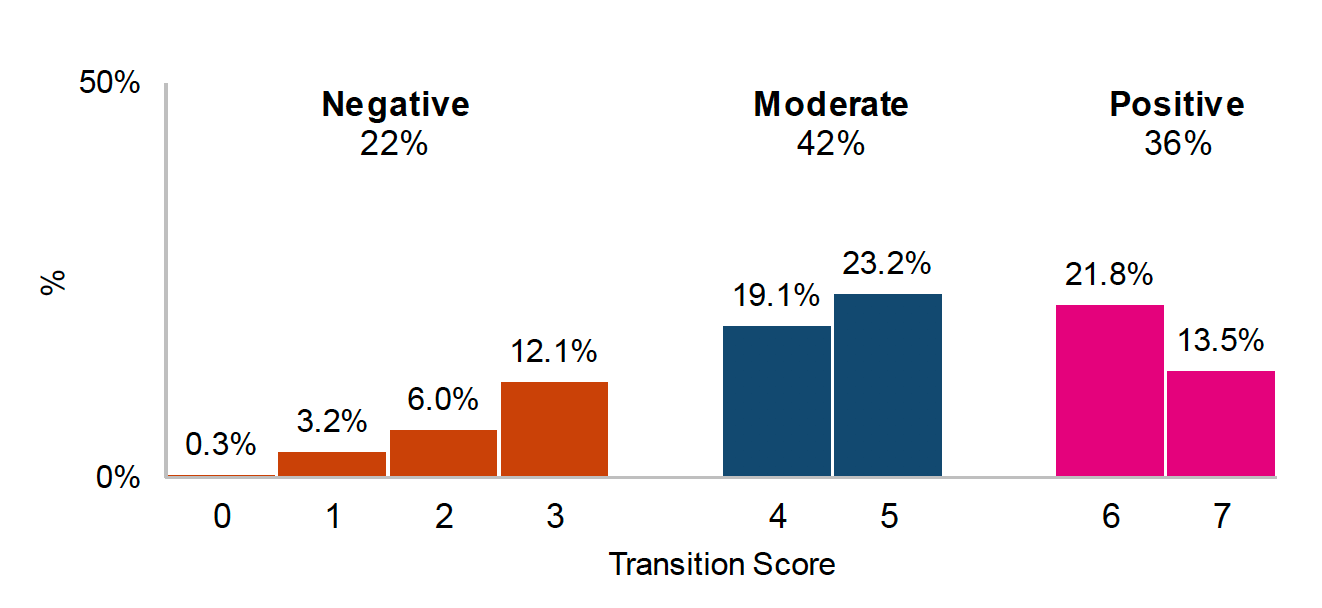
Note. Data drawn from GUS sweeps 8 and 9. Unweighted base: n=2559. Numbers indicate weighted percentages.
3.3. Relationship with peers
Data from several questions asked of children and parents when the child was in S1 were used to explore peer relationships. These included:
- Child
- How many of your friends from primary school are you still friendly with?
- How easy/difficult was it to make new friends?
- How many of your friends from primary school are attending the same secondary school as you?
- How often do other children pick on you…by calling you names or making fun of you? …by leaving you out of games and chats? …by shoving, pushing, hitting or picking a fight with you?
- Parent:
- Whether child was anxious about making new friends
- Whether child misses old friends from primary school
- Whether child had made new friends at secondary school
Children generally reported positive feelings regarding their relationship with peers in their first year of secondary school (Table 9‑2). Although the vast majority (83%) attended secondary school with at least most (if not all) of their friends from primary, fewer, though still nearly two thirds, (64%) said that they were still friendly with most or all of their primary school friends and 5% were no longer friends with anyone from primary school. This proportion was similar among those who did not attend secondary with any of their friends from primary school and those who did. Therefore, although experiences were predominantly positive in this regard, the transition to secondary school was nevertheless associated with a shift in peer group and social circles.
When it comes to making new friends only 15% of children felt it was hard for them to do so (Table 9‑2). This finding aligns with parent reports of children's experiences (Table 9‑4), with 19% reporting that their child was anxious about making new friends at S1, and 69% reporting that their child was not anxious. Additionally, 95% agreed their child had made new friends in secondary school, while a large majority (72%) did not feel that their child missed their primary school friends. For most children, the transition to secondary school did not seem to be associated with significant concerns regarding peer groups, although this does appear to be a concerning aspect for a minority of children.
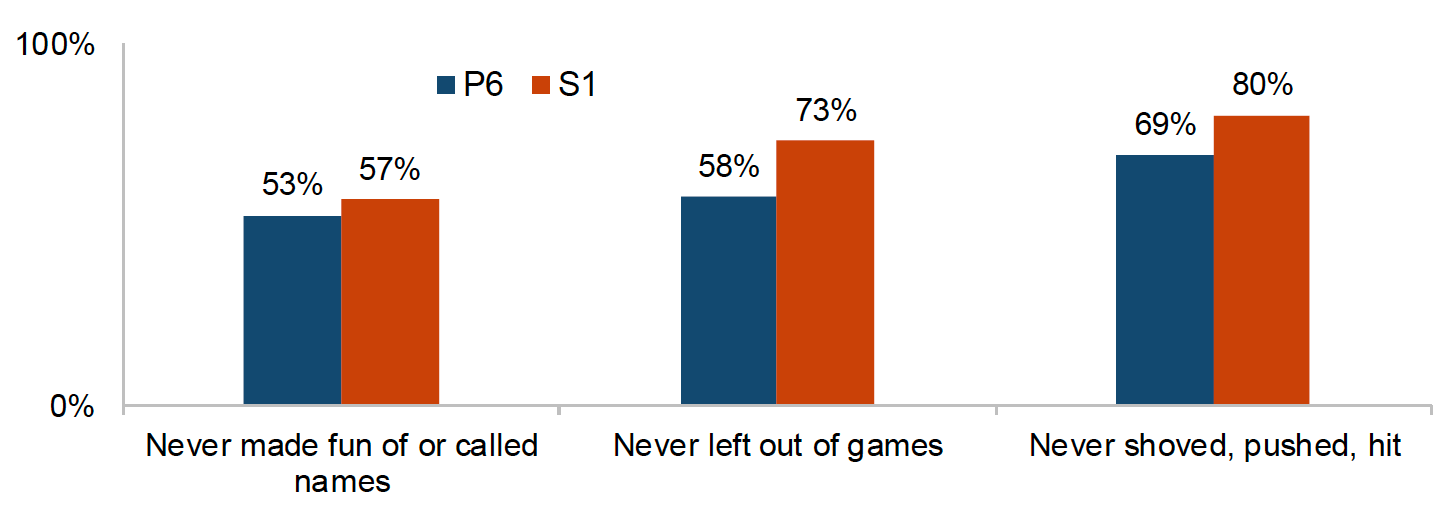
Additionally, reports of bullying in primary and secondary indicated an overall positive trend, with a reduction in all forms of bullying being reported after children had started secondary school (Figure 3‑2). After moving to secondary school, children were more likely to report never being bullied by being made fun of or called names, being left out of games, and being shoved, pushed or hit[23]. The smallest reduction, however, was seen amongst reports of being called names and made fun of. This was also the most prevalent form of bullying both in primary and secondary school.
3.4. Relationship with teachers
Only one measure of teacher relationship is available in GUS – child reports of being treated fairly by teachers (Table 9‑2). This variable was included at both sweep 8 and sweep 9, allowing for comparison between primary (measured in P6) and secondary school (measured in S1). As shown in Figure 3‑3 the transition to secondary school was associated with a considerable decline in children perceiving they are 'always' being treated fairly by teachers.
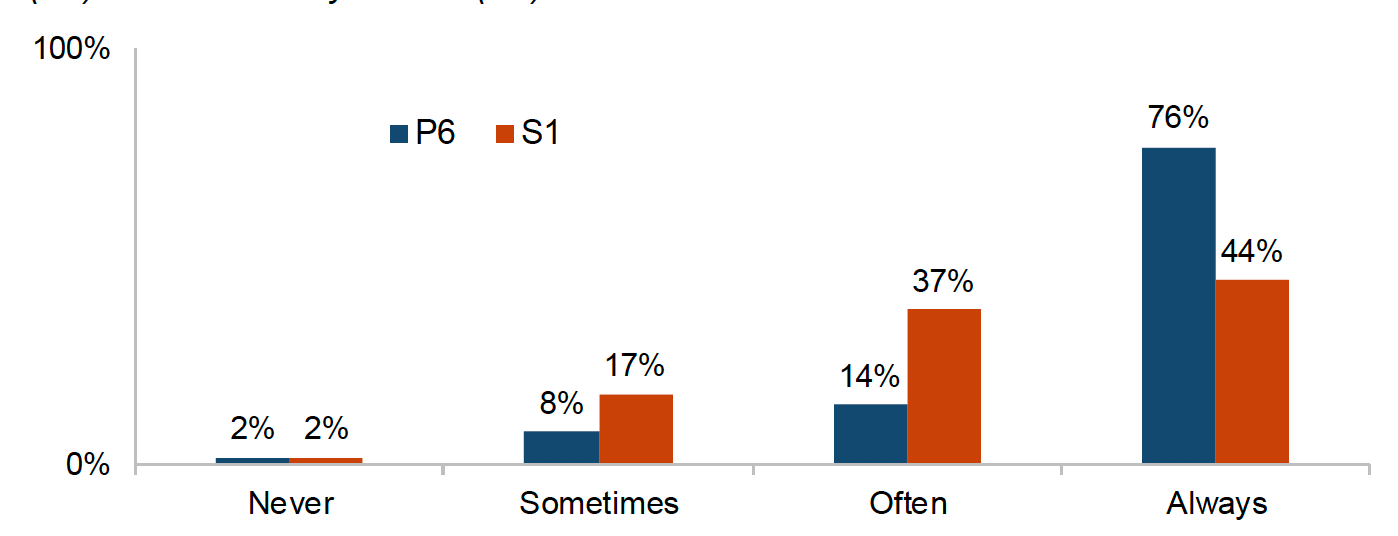
Note. P6 data drawn from GUS sweep 8 (Table 9‑1), unweighted base: n=3,088. S1 data from sweep 9 (Table 9‑2), unweighted based: n=3,282. Numbers indicate weighted percentages.
3.5. Learning
Aspects of learning in secondary school were measured using five questions, three asked of children and two asked of parents. The child questions asked how easy or difficult they found maths, how or easy or difficult they found English and how pressured they felt by the schoolwork they had to do. For parents, the questions used asked whether the extent to which they agreed or disagreed that their child received too much homework and that their child was coping well with school work.
Children predominantly felt that the level of difficulty in secondary school was appropriate, neither too hard or too easy, for both maths (78% of children) and English (79%) (Table 9‑2). Additionally, there were relatively few child reports of feeling overly pressured by their schoolwork, with 14% of children feeling pressured 'quite a lot' or 'a lot' (see Figure 3‑4).
Child reports were supported by parent reports regarding levels of school work. Overall, 7% of parents felt that their child received too much homework, while 90% felt that their child was coping well with their school work (Table 9‑4).
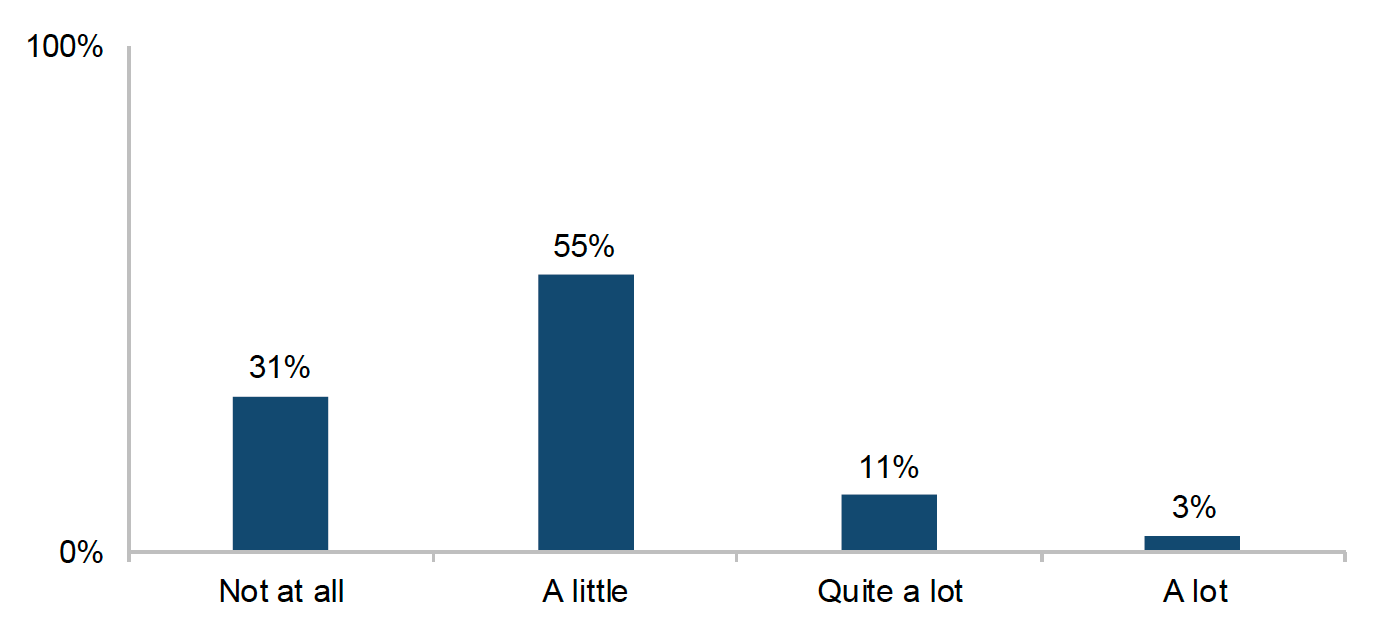
Note. Data drawn from GUS sweep 9, unweighted base: n=3176. Numbers indicate weighted percentages.
3.6. Engagement and motivation
Engagement and motivation were measured using the following items from the data:
- I look forward to going to school
- I hate school
- How often do you try your best at school?
- How much do you like reading (P6)/How much do you like English (S1)?
- How much do you like doing number work (P6)/How much do you like maths (S1)?
- Have you ever skipped school when your parents didn't know even if only for a half day or a little while/single lesson?
- Whether school has been in contact with parent regarding child's behaviour, attendance etc.
Other than the last question which was asked of parents, all items were reported by the study child. Each question was included at both sweep 8 and sweep 9, allowing for comparison between primary (measured in P6) and secondary school (measured in S1).
Children at secondary school were more likely to report hating school (15% 'often' and 'always') (see Figure 3‑5) and were less likely to look forward to going to school (46% 'never' and 'sometimes') (Table 9‑2) compared to primary school (10% and 42% respectively)).
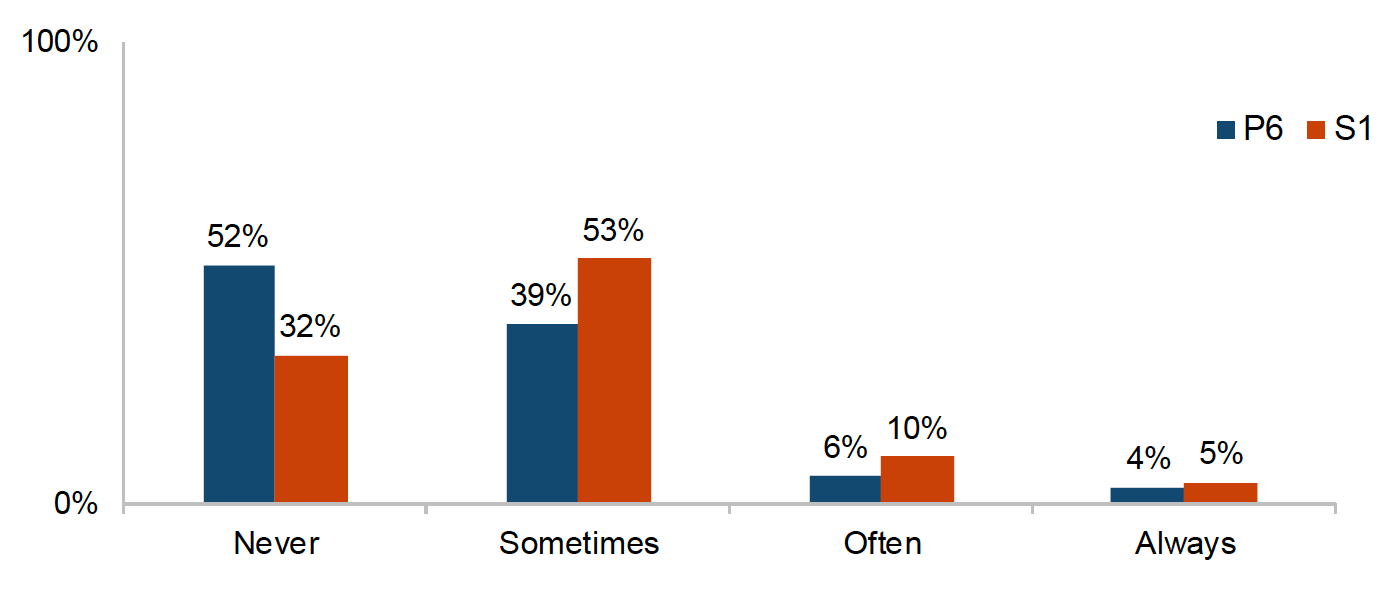
Note. P6 data drawn from GUS sweep 8, unweighted base: n=3,087. S1 data drawn from sweep 9, unweighted base: n=3,283. Numbers indicate weighted percentages.
Similarly, children reported liking both English and maths less in secondary than they did in primary (Table 9‑1), indicating that their decreased engagement and motivation related both to school generally as well as to subject specific aspects.
However, although children were slightly less likely to 'always' try their best after starting secondary school (62% reported this in P6, 57% in S1), they were just as likely to try their best 'most of the time' or 'always' (93% in P6, 93% in S1).
Contact
Email: GUS@gov.scot
There is a problem
Thanks for your feedback